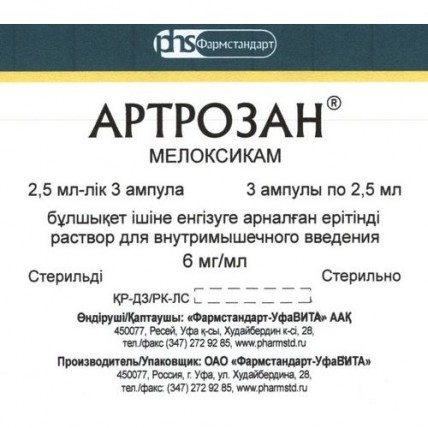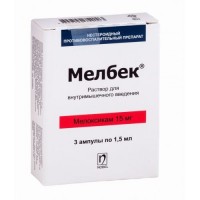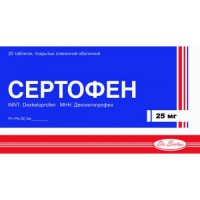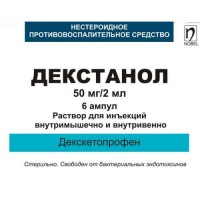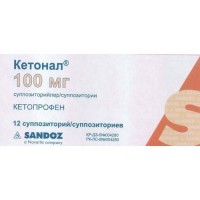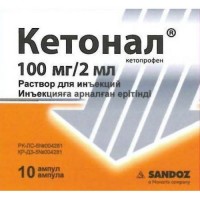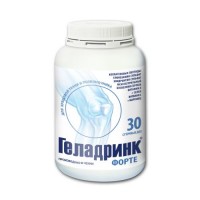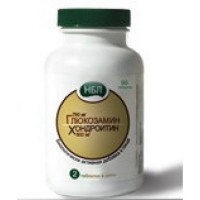Artrozan 6 mg / ml 2.5 ml 3's solution for intramuscular administration
- $15.30
The instruction for medical use of ARTROZAN® medicine the Trade name of Artrozan® the International unlicensed name Meloksikam Lekarstvennaya a form Solution for intramuscular introduction of 6 mg/ml. The structure One ml of solution contains active agent: to meloksika – 6 mg excipients: meglumin, half-oxameasures 188 (lutrol F68), glikofurol, glycine, sodium chloride, 1 M hydroxide sodium solution, water for injections. Description Transparent chartreuse liquid. Pharmacotherapeutic group Non-steroidal anti-inflammatory drugs. Oksikama. Meloksikam. The ATX M01AC06 code the Pharmacological Pharmacokinetics Binding properties with proteins of plasma makes 99%. Drug gets through gistogematichesky barriers, concentration in synovial fluid makes 50% of the maximum concentration in plasma. Almost it is completely metabolized in a liver with formation of four inactive derivatives in the pharmacological relation. The main metabolite, 5 '-karboksimeloksikam (60% of dose size), is formed by oxidation of an intermediate metabolite, 5 '-hydroksimetilmeloksikama which is also excreted, but to a lesser extent (9% of dose size). The researches in vitro showed that in this metabolic transformation an important role is played by an isoenzyme of CYP 2C9, the additional value has an isoenzyme of CYP 3A4. In formation of two other metabolites (making, respectively, 16% and 4% of drug dose size), peroxidase which activity probably varies takes part. The plasma clearance averages 8 ml/min. At elderly people the clearance of drug decreases. Distribution volume low, also is, on average 11 l. The liver or renal failure of moderate severity has no significant effect on pharmacokinetics of a meloksikam. It is removed in an equal proportion with a stake and urine, mainly in the form of metabolites. Through intestines in not changed look less than 5% of a daily dose are removed, in urine in not changed look drug is found only in trace quantities. Elimination half-life (Т½) the meloksikama makes from 13 to 25 hours. A pharmacodynamics of Artrozan® – the non-steroidal anti-inflammatory drug (NPVP) possessing anti-inflammatory, febrifugal and analgeziruyushchy action. Belongs to the class of oksikam, is derivative enoliyevy acid. The mechanism of action is connected with inhibition of synthesis of prostaglandins as a result of selective braking of enzymatic activity of the cyclooxygenase of the second type (TsOG-2) participating in biosynthesis of prostaglandins in the field of inflammation. When assigning in high doses, prolonged use and specific features of an organism the selectivity concerning TsOG-2 decreases. To a lesser extent affects the cyclooxygenase of the first type (TsOG-1) participating in synthesis of the prostaglandins which are protecting a mucous membrane of a GIT and taking part in regulation of a blood-groove in kidneys. At the expense of the specified selectivity of suppression of activity of TsOG-2, drug causes GIT erosive cankers less often. Indications Symptomatic and short-term treatment of the inflammatory and degenerative diseases of a musculoarticulate system which are followed by a pain syndrome including: - an osteoarthrosis - a pseudorheumatism - an ankylosing spondylitis (Bekhterev's disease) the Route of administration and doses Intramuscular administration of drug is shown in the first 2-3 days of treatment. Further treatment is continued using oral forms (tablet). The recommended dose makes 7.5 or 15 mg of 1 times a day, depending on intensity of pains and weight of inflammatory process. As the potential risk of side reactions depends on a dose and duration of treatment should use the smallest effective doses and minimum possible short course. At the patients with a heavy renal failure who are on a hemodialysis, the dose should not exceed 7.5 mg a day. The drug is administered by means of a deep injection in oil. Contents of ampoules should not be mixed in one syringe with other medicines. The drug cannot be administered intravenously. Side effects - the leukopenia, thrombocytopenia, anemia the Contributing factor for emergence of a cytopenia is simultaneous use of potentially myelotoxic medicines, in particular a methotrexate. - an acute anaphylaxis, anaphylactoid reactions and other reactions of immediate hypersensitivity - confusion of consciousness, orientation disturbance, emotional lability - dizziness, a headache, drowsiness - conjunctivitis, disorders of vision, including illegibility of sight, emergence of a veil before eyes - sonitus, vertigo - heartbeat, increase in arterial blood pressure, feeling of rush of blood to the person - at predisposed patients perhaps acute development of bronchial asthma - stomatitis, an esophagitis, gastritis, digestive tract erosive cankers, colitis, perforation of digestive tract, the concealed or obvious gastrointestinal hemorrhage - nausea, vomiting, an eructation, an abdominal pain, diarrhea, a constipation, a meteorism. Gastrointestinal bleeding, an ulcer and perforation can potentially lead to a lethal outcome. - hepatitis, passing changes of indicators of function of a liver (increase in activity of transaminases or bilirubin) - a toxic epidermal necrolysis, Stephens-Johnson's syndrome, an angioedema, bullous dermatitis, a multiformny erythema, rash, a small tortoiseshell, a photosensitization, an itching - an acute renal failure, interstitial nephrite, changes of indicators of function of kidneys (increase in level of creatinine and/or urea in blood serum, an albuminuria, a hamaturia), urination difficulty, including a sharp ischuria - hypostases, puffiness in the injection site, painful feelings, consolidation in the injection site of the Contraindication hypersensitivity to a meloksikam or any other component of drug hypersensitivity to acetylsalicylic acid and other non-steroidal anti-inflammatory drugs. Артрозан® patients at whom is in the anamnesis after prescribing of acetylsalicylic acid or other NPVS should not appoint symptoms of bronchial asthma, nasal polyps, a Quincke's disease were observed, a small tortoiseshell the patients receiving anticoagulants should not appoint, considering possible risk of developing an intramuscular hematoma erosive and ulcer changes mucous a stomach and duodenum/perforation in a phase of aggravation or the aggravations which are recently postponed nonspecific ulcer colitis in a phase, Crohn's disease the profound liver failure, liver diseases in the acute stage gastrointestinal bleeding, recently postponed cerebrovascular bleeding or system disturbances of blood clotting the progressing disease of kidneys, the profound renal failure (if the hemodialysis), clearance of creatinine less than 30 ml/min. dekompensirovanny heart failure a postoperative pain syndrome after aortocoronary shunting (imposing of a roundabout anastomosis) children's and teenage age to 18 years pregnancy and the period of a lactation Medicinal interactions At simultaneous use with other NPVP (including with acetylsalicylic acid is not carried out) increases risk of developing of erosive cankers and gastrointestinal bleedings. At simultaneous use with hypotensive drugs the decrease in efficiency of action of the last is possible. At simultaneous use with drugs of lithium the development of cumulation of lithium and increase in its toxic action is possible (control of concentration of lithium in blood is recommended). At simultaneous use with a methotrexate the side effect of the last on the haematogenic system amplifies (danger of developing of anemia and a leukopenia, periodic performing the general blood test is shown). At simultaneous use with diuretics and cyclosporine the risk of developing a renal failure increases. At simultaneous use with intrauterine contraceptive means the decrease in efficiency of action of the last is possible. At simultaneous use with anticoagulants (heparin, warfarin), thrombolytic drugs (streptokinase, fibrinolysin), and antiagregant (tiklopidin, klopidogret, acetylsalicylic acid) risk of developing bleedings increases (periodic control of indicators of blood clotting is necessary). At simultaneous use with Colestyraminum the removal of a meloksikam through a GIT accelerates. At simultaneous use with selective serotonin reuptake inhibitors the risk of developing gastrointestinal bleedings increases. Special instructions As well as at use of other NPVP, at treatment there can be potentially fatal gastrointestinal bleeding, expression or perforation as with existence of alarming symptoms or serious gastrointestinal violations in the anamnesis at any time, and without them. Consequences of such disturbances, as a rule, are more serious at elderly people. It is necessary to show care at treatment of patients with a gastrointestinal disease in the anamnesis. It is necessary to control patients with gastrointestinal symptoms. Артрозан® it is necessary to cancel when developing a round ulcer or gastrointestinal bleeding. Due to the use of Artrozana® it was occasionally reported about serious skin reactions (some of which were led to death), including exfoliative dermatitis, Stephens-Johnson's syndrome and a toxic epidermal necrolysis. The greatest risk of these reactions at patients, apparently, takes place at the beginning of therapy, and in most cases reaction is shown within the first month of treatment. Reception of Artrozana® should be stopped at the first appearance of skin rash, defeats mucous or any other sign of hypersensitivity. NPVP can increase risk of developing serious cardiovascular trombotichesky diseases, a myocardial infarction and stroke which can lead to death. This risk can increase together with therapy duration. Patients with cardiovascular diseases or risk factors of cardiovascular diseases can be exposed to big risk. NPVP inhibit synthesis of prostaglandins of kidneys which play a supporting role in maintenance of a blood-groove in kidneys. With the lowered renal blood-groove and volume of blood the introduction of NPVP can cause the expressed renal decompensation in patients, at the termination of therapy of NPVP the function of kidneys is usually restored to an initial state. Elderly people, patients with dehydration, with stagnant heart failure, cirrhosis, a nephrotic syndrome and the profound disease of kidneys, the patients receiving the accompanying treatment using diuretics, APF inhibitors or antagonists of a receptor of angiotensin II or the patients who were exposed to the extensive surgery which led to a hypovolemia are subject to the greatest risk. At such patients in an initiation of treatment it is necessary to control carefully functions of kidneys, including diuresis volume. In rare instances NPVP can cause interstitial nephrite, a glomerulonephritis, medullary necrosis of kidneys or a nephrotic syndrome. The dose of Artrozana® at the patients with an end-stage of a renal failure who are on a hemodialysis should not exceed 7.5 mg. For patients with slight and moderate renal failures (i.e. patients with clearance of creatinine have more than 25 ml/min.) the dose decline is not required. As well as at use of other NPVP, increase in level of transaminases in serum of blood or other parameters of function of a liver is sometimes noted. In most cases these effects represented the slight taking place increase of parameters above normal values. If such anomaly is considerable or resistant, reception of Artrozana® it is necessary to stop and perform necessary examination of the patient with the subsequent observation. For patients with clinically stable cirrhosis the dose decline is not required. The painful or weakened patients can worse transfer side effects, in this case careful control is necessary. As well as at use of other NPVP, it is necessary to show care at treatment of elderly patients who more likely suffer from a renal failure, a liver or heart. NPVP can cause a delay of sodium, potassium and water and to prevent natriuretic effect of diuretics. As a result at the patients subject to these effects, heart failure or hypertensia can amplify or become aggravated. For patients of risk group the clinical monitoring is recommended. Meloksikam, as well as any other NPVP, can mask symptoms of the basic infectious disease. Fertility. Use of a meloksikam, as well as any other drug inhibiting cyclooxygenase/synthesis of prostaglandins can affect reproductive ability and is not recommended to the women planning pregnancy. Thus, for women who have difficulties with conception or are exposed to researches in connection with infertility, it is necessary to consider cancellation of reception of a meloksikam. Features of influence of medicine on ability to run the vehicle or other potentially dangerous mechanisms of the Research of influence on ability to drive the car and to use mechanisms were not carried out. Nevertheless, patients should be informed on possible manifestation of undesirable effects, such as disorder of vision, including illegibility of sight, dizziness, drowsiness, other disturbances of the central nervous system. In case of any of the specified side effects the patients have to avoid control of vehicles and refuse work with potentially dangerous mechanisms. Overdose Symptoms: consciousness disturbance, nausea, vomiting, pains in epigastriums, bleeding in digestive tract, an acute renal failure, a liver failure, an apnoea, an asystolia. Treatment: symptomatic. There are no specific antidotes. A form of release and packing On 2.5 ml of drug in ampoules with a capacity of 5 ml with two rings of green and yellow color in an upper part of an ampoule. On 3 or 5 ampoules place in blister strip packaging from a film polyvinylchloride without foil. 2 planimetric packs on 5 ampoules or 1 planimetric packing on 3 ampoules together with the instruction for medical use in the state and Russian languages place in a pack from cardboard. To Store storage conditions in the place protected from light at a temperature not above 25 °C. To store out of children's reach! Period of storage of 5 years. Not to use after the expiration date specified on packing! Prescription status According to the prescription
JSC Pharmstandard-UfaVITA Razvernut Producer
JSC Pharmstandard-UfaVITA Razvernut Producer
